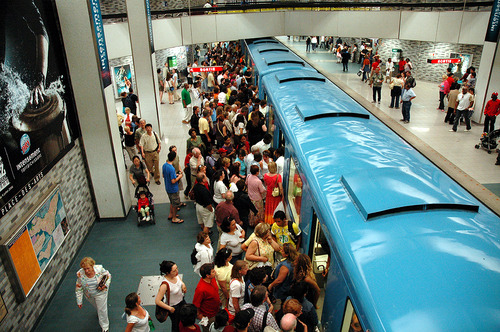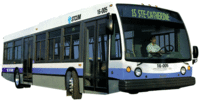Société de Transport de Montréal Backgrounder

STM:
In a city as densely populated as Montreal, people need to know how to get around. Montreal's solution is The Société de Transport de Montréal
(STM for short) which provides public transportation all across the
island. For anyone new to the city, or unaware of the services that are
available, there are many reasons proving how public
transportation is an efficient, cost effective and environmentally-friendly way to travel.
History:
Like much of
Montreal, the STM has a historic past. Today it is the fourteenth
largest employer in Quebec employing 7400 people. It first appeared as the Montreal City
Passenger Railway Company in 1861, possessing 6 miles of railway, one
stable, one shed, 8 vehicles and 14 horses. The first stretch of track
ran on Notre-Dame between Du Havre and McGill. Between 1892 and 1894,
electric street cars took over and put an end to horse-drawn ones. In
1919, the first buses appeared and were seen as the future of urban
transit.
The first modern street trolley in Canada appeared in 1937,
but was fairly short lived and replaced by the metro in 1966. Since then,
the metro has become the flagship vehicle of the STM's fleet. The STM
has had countless name changes over its nearly 150 years in operation,
the last one being in 2002 when all the municipalities on the island
were merged. The Société de transport de la Communauté Urbaine de
Montréal, then became the STM that we know today.
Buses:
 In
2010, the STM provided over 1.3 million trips per day and has nearly 1600 busses running on 192 bus routes, which includes about
8500 stops. Buses account for 2% of the air pollution in Montreal,
while cars account for 50%. When we take into consideration the number
of people buses can transport, they pollute 18 times less than cars.
The current model used by the STM, called the Novabus, made its
appearance in the 1990s and features improved access for senior
citizens and wheelchair users. There are also some of 1980s Classic models still on the road.
In
2010, the STM provided over 1.3 million trips per day and has nearly 1600 busses running on 192 bus routes, which includes about
8500 stops. Buses account for 2% of the air pollution in Montreal,
while cars account for 50%. When we take into consideration the number
of people buses can transport, they pollute 18 times less than cars.
The current model used by the STM, called the Novabus, made its
appearance in the 1990s and features improved access for senior
citizens and wheelchair users. There are also some of 1980s Classic models still on the road.Metro:
 The Montreal
Metro is Canada's largest metro service, named so after the French term
for "Subway" or "chemin the fer métropolitain", the word "metro" for
short has become the name used by both French and English speaking
Montrealers.
The Montreal
Metro is Canada's largest metro service, named so after the French term
for "Subway" or "chemin the fer métropolitain", the word "metro" for
short has become the name used by both French and English speaking
Montrealers. The metro serves an average of
1,050,800 people per day. As of 2006, the metro has transported over 6
billion passengers. The system is divided into 4 lines, covering a
total of 66 kilometres and 65 stations. It runs completely underground,
due, in part, to Montreal's harsh winters. It also lets the metro hold
the title of the first subway system ever, to run completely on rubber
tires, which wouldn't be practical if it were outdoors. The
metro's design was inspired by the Paris metro system and both are characterized by stations which have unique architecture and artistic
elements.
Future:
The
STM is continually planning for the future. The city is looking to go
completely electric by replacing its entire fleet of diesel buses by
2025 and if accomplished, Montreal will be the first North
American city to do so. The STM says that starting in 2012, every bus
that it purchases will be either electric or hybrid, a good first step
towards their ambitious goal.
The metro system is
also rapidly expanding having extended into Laval in 2007. Plans
are now in the works to lengthen the blue line into the east end, and
loop the orange line connecting the Cote Vertu and Montmorency stations. Big plans have been made to replace the metro's
aging cars, which have been in operations since 1976. The new cars,
which are scheduled to appear in 2012, will feature more seating, a
comfier ride, high definition TV screens showing streaming news feeds and improved wheelchair access as seen in the video below:
Montrealers
have been shown to use public transportation for about 13% of travel in the city. A high percentage compared to the average of 3% throughout major cities across the United States. This
directly translates to more money in the pockets of Montreal families
who use public transit - Montreal households spend roughly 26% less on
transportation than households in areas outside of Montreal. When all this is taken into account, it's no wonder the
American Public Transportation Association named the STM as one of the
best public transportation systems in North America.
Article by Robert Flis

Leave a comment